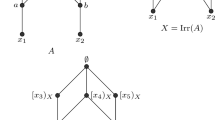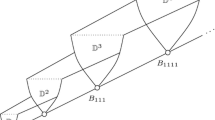Abstract
In this article we will focus our attention on the variety of distributive bisemilattices and some linguistic expansions thereof: bounded, De Morgan, and involutive bisemilattices. After extending Balbes’ representation theorem to bounded, De Morgan, and involutive bisemilattices, we make use of Hartonas–Dunn duality and introduce the categories of 2spaces and 2spaces\(^{\star }\). The categories of 2spaces and 2spaces\(^{\star }\) will play with respect to the categories of distributive bisemilattices and De Morgan bisemilattices, respectively, a role analogous to the category of Stone spaces with respect to the category of Boolean algebras. Actually, the aim of this work is to show that these categories are, in fact, dually equivalent.
Similar content being viewed by others
References
Åqvist, L., Reflections on the Logic of Nonsense, Theoria 28(2):138–157, 1962.
Arieli, O., and A. Avron, The Value of Four Values, Artificial Intelligence 102:97–141, 1998.
Asenjo, F. G., and J. Tamburino, Logic of Antinomies, Notre Dame Journal of Formal Logic 16(1):17–44, 1975.
Belnap, N. D., A Useful Four Valued Logic, in G. Epstein, and J. M. Dunn (eds.), Modern Uses Multiple Valued Logic, Reidel Publishing Company, Boston, 1977, pp. 7–73.
Balbes, R., A Representation Theorem for Distributive Quasi-Lattices, Fundamenta Mathematicae 68(2):207–214, 1970.
Bochvar, D. A., On a Three-Valued Calculus and Its Application in the Analysis of the Paradoxes of the Extended Functional Calculus, Mathematicheskii Sbornik 4:287–308, 1938.
Bonzio, S., I. Chajda, and A. Ledda, Representing Quantum Structures as Near Semirings. Logic Journal of the IGPL first published online: 24 May 2016.
Brzozowski, J. A., De Morgan Bisemilattices, in 30th IEEE International Symposium on Multiple-Valued Logic, IEEE Press, Los Alamitos, Portland, May 2000, pp. 23–25.
Brzozowski, J. A., Partially Ordered Structures for Hazard Detection. in Special Session of The Many Lives of Lattice Theory, Joint Mathematics Meetings, San Diego, January 69, 2002.
Clark, D. M., and B. A. Davey, Natural Dualities for the Working Algebraist, Cambridge University Press, Cambridge, 1998.
Cobreros, P., P. Égré, D. Ripley, and R. Van Rooij, Foreword: Three-Valued Logics and Their Applications, Journal of Applied Non-Classical Logics 24(1–2):1–11, 2014.
Davey, B. A., The Product Representation Theorem for Interlaced Pre-bilattices: Some Historical Remarks, Algebra Universalis 70:403–409, 2013.
Finn, V., and R. Grigolia, Nonsense Logics and Their Algebraic Properties, Theoria 59(1–3):207–273, 1993.
Fitting, M., Bilattices and the Semantics of Logic Programming, The Journal of Logic Programming 11(2):91–116, 1991.
Gehrke, M., C. Walker, and E. Walker, A Mathematical Setting for Fuzzy Logics, International Journal of Uncertainty, Fuzziness, and Knowledge-Based Systems 5(3):223–238, 1997.
Gehrke, M., C. Walker, and E. Walker, Some Comments on Fuzzy Normal Forms, Proceedings of the Ninth IEEE International Conference on Fuzzy Systems, FUZZ-IEEE, vol. 2, 2000, pp. 593–598.
Gierz, G., K. H. Hofmann, K. Keimel, and J. D. Lawson, Continuous Lattices and Domains, Cambridge University Press, Cambridge, 2003.
Gierz, G., and A. Romanowska, Duality for Distributive Bisemilattices, Journal of the Australian Mathematical Society 51:247–275, 1991.
Gil Férez, J., L. Peruzzi, S. Bonzio, and F. Paoli, On Paraconsistent Weak Kleene Logic, Studia Logica 105(2):253–297, 2017.
Glazek, K., A Guide to the Literature on Semirings and Their Applications in Mathematics and Information Sciences, Springer, Berlin, 2002.
Goldblatt, R. I., The Stone Space of an Ortholattice, Bulletin of the London Mathematical Society 7:45–48, 1975.
Johnstone, P. T., Stone Spaces, Cambridge Studies in Advanced Mathematics, vol 3, Cambridge University Press, Cambridge, 1982.
Halldén, S., The Logic of Nonsense, Lundequista Bokhandeln, Uppsala, 1949.
Harding, J., and A. Romanowska, Varieties of Birkhoff Systems. Part I. Order (online), 2016.
Harding, J., and A. Romanowska, Varieties of Birkhoff Systems. Part II. Order, 2016.
Hartonas, C., and M. Dunn, Duality Theorems for Partial Orders, Semillatices, Galois Connections and Lattices. I.U. Logic Group Preprint series, IULG-93-26.
Hartonas, C., and M. Dunn, Stone Duality for Lattices, Algebra Universalis 37:391–401, 1997.
Hájek, P., Metamathematics of Fuzzy Logic, Trends in Logic, vol 4, Kluwer, Dordrecht, 1998.
Kalman, J., Subdirect Decomposition of Distributive Quasi-Lattices, Fundamenta Mathematicae 71(2):161–163, 1971.
Kamp, H., Two Theories About Adjectives, in Formal Semantics of Natural Language, Cambridge University Press, Cambridge, 1975, pp. 123–155.
Kleene, S. C., Introduction to Metamathematics, North Holland, Amsterdam, 1952.
Kleene, S. C., On a Notation for Ordinal numbers, Journal of Symbolic Logic 3:150–155, 1938.
Kneale, W., and M. Kneale, The Development of Logic, 84 edition, Oxford University Press, Oxford, 1984.
Knoebel, A., A Comment on Balbes Representation Theorem for Distributive Quasilattices, Fundamenta Mathematicae 90:187–188, 1976.
Kondo, M., Characterization Theorem of 4-Valued De Morgan Logic, Memoirs of the Faculty of Science and Engineering Shimane University. Series B. Mathematical Science 31:73–80, 1998.
Körner, S., Expertise and Theory: An Essay in the Philosophy of Science, Humanities Press, New York, 1966.
Kripke, S., Outline of a Theory of Truth, Journal of Philosophy 72(19):690–716, 1975.
Malinowski, G., Many-Valued Logic, in D. M. Gabbay, and J. Wood (eds.), The Many Valued and Nonmonotonic Turn in Logic, 1st edition, vol 8: 13–94, North Holland, Amsterdam, 2007.
Markov, A. A., Constructive Logic, Uspekhi Matematicheskikh Nauk 5:187–188, 1950 (in Russian).
Martin, J., Elements of Formal Semantics, Academic Press, Orlando, 1987.
McKenzie, R., and A. Romanowska, Varieties of Distributive Bisemilattices, Contributions to General Algebra 1:213–218, 1979.
Mobasher, B., D. Pigozzi, and G. Slutzki, Multi-valued Logic Programming Semantics—An Algebraic Approach, Theoretical Computer Science 171:77–109, 1997.
Omori, H., Halldén’s Logic of Nonsense and Its Expansions in View of Logics of Formal Inconsistency. in 27th International Workshop on Database and Expert Systems Applications, 2016, pp. 129–133.
Padhmanabhan, R., Regular Identities in Lattices, Transactions of the American Mathematical Society 158(1):179–188, 1971.
Pawlak, Z., Rough Sets: Theoretical Aspects of Reasoning about Data, Springer, Berlin, 1991.
Płonka, J., On Distributive Quasilattices, Fundamenta Mathematicae 60:191–200, 1967.
Płonka, J., On the Sum of a Direct Systems of Universal Algebras with Nullary Polynomials, Algebra Universalis 19:197–207, 1984.
Płonka, J., and A. Romanowska, Semilattice Sums, in A. Romanowska and J. D. H. Smith (eds.), Universal Algebra and Quasigroup Theory, Heldermann, Berlin, 1992, pp. 123–158.
Priest, G., The Logic of Paradox, Journal of Philosophical Logic 8:219–241, 1979.
Priestley, H., Representation of Distributive Lattices by Means of Ordered Stone Spaces, Bulletin of the London Mathematical Society 2:186–190, 1970.
Priestley, H., Ordered Topological Spaces and the Representation of Distributive Lattices, Proceedings of the London Mathematical Society 3:506–530, 1972.
Prior, A., Time and Modality, Oxford University Press, Oxford, 1957.
Rasiowa, E., and A. Skowron, Approximation Logic. in Proceedings of the International Spring School on Mathematical Method of Specification and Synthesis of Software Systems ’85, Springer, Berlin, 1986, pp. 123–139.
Romanowska, A., On Bisemilattices with One Distributive Law, Algebra Universalis 10:36–47, 1980.
Romanowska, A., Free Bisemilattices with One Distributive Law, DemonsDemonstratio Mathematica 13:565–572, 1980.
Romanowska, A., On Distributivity of Bisemilattices with One Distributive Law, Colloquia Mathematica Societatis Janos Bolyai 29:653–661, 1982.
Romanowska, A., and J. D. H. Smith, Bisemilattices of Subsemilattices, Journal of Algebra 70(1):78–88, 1981.
Romanowska, A., and J. D. H. Smith, Semilattice-Based Dualities, Studia Logica 56(1/2):225–261, 1996.
Segerberg, K., A Contribution to Nonsense-Logics, Theoria 31:199–217, 1964.
Smiley, T., Sense Without Denotation, Analysis 20(6):125–135, 1960.
Stone, M. H., The Theory of Representations of Boolean Algebras, Transactions of the American Mathematical Society 40:37–111, 1936.
Stone, M. H., Topological Representations of Distributive Lattices and Brouwerian Logics, Časopis Pěstovani Matematiky 67:1–25, 1937.
van Eijck, J., Presupposition Failure: A Comedy of Errors, Formal Aspects of Computing 6(6):766–787, 1994.
Williamson, T., Vagueness, Routledge, London, 1994.
Acknowledgements
The author gratefully acknowledges the support of the Horizon 2020 program of the European Commission: SYSMICS project, Proposal Number: 689176, MSCA-RISE-2015, the support of the Italian Ministry of Scientific Research (MIUR) within the FIRB project “Structures and Dynamics of Knowledge and Cognition”, Cagliari, Proposal Number: F21J12000140001, and the support of Fondazione Banco di Sardegna within the project “Science and its Logics: The Representation’s Dilemma”, Cagliari, Proposal Number: F72F16003220002. The writer wishes to express his gratitude to Francesco Paoli for calling his attention to the topic of this article, and José Gil-Férez for the insightful discussions. Finally, the author feels deeply indebted to Heinrich Wansing and to the anonymous Studia Logica’s reviewers for their careful advices, which helped a lot to improve this article.
Author information
Authors and Affiliations
Corresponding author
Additional information
Presented by Heinrich Wansing
Rights and permissions
About this article
Cite this article
Ledda, A. Stone-Type Representations and Dualities for Varieties of Bisemilattices. Stud Logica 106, 417–448 (2018). https://doi.org/10.1007/s11225-017-9745-9
Received:
Published:
Issue Date:
DOI: https://doi.org/10.1007/s11225-017-9745-9




